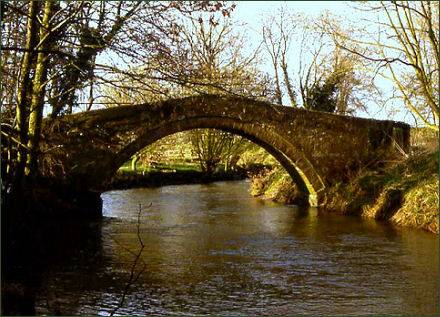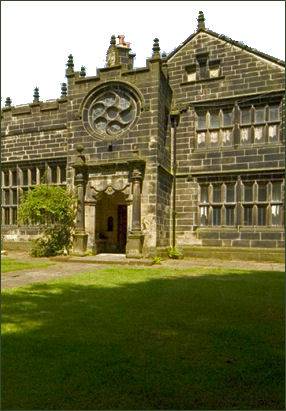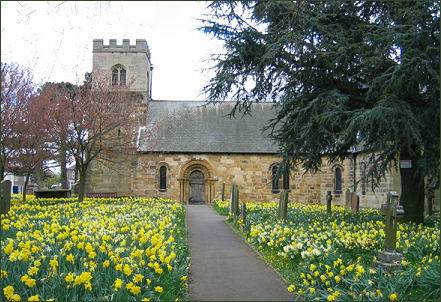Sowerby
OS grid reference:-SE 431 810
 The village of Sowerby is located to the south of Thirsk. The boundary of the village merges with that of Thirsk, although it retains a separate identity, it could be described as a suburb of the town.
The village of Sowerby is located to the south of Thirsk. The boundary of the village merges with that of Thirsk, although it retains a separate identity, it could be described as a suburb of the town.
Sowerby's name derives from the Old Norse language, and means 'Farmstead (by the) muddy/sour ground'. The lines of a Roman road can still be seen in the fields to the north and east of the village along the Green Lane and was known as The Saxty Way. The village is mentioned in the Domesday Book of 1086 where it is referred to as Sorebi.
At the time of the Norman conquest, the land was split between Earl Morcar and Ligulf, who granted land to Orm. Following the conquest it became the property of the crown. The overlordship was granted to the Mowbray family, who granted land to William Lascelles in 1228. The Lascelles family held their manor until 1602, when it was sold to the Meynell family. The manor has followed the inheritance of the manor at North Kilvington since then.
 The centre of the village has an avenue of English lime trees, planted to celebrate the jubilee of Queen Victoria in 1887, on its long road, are an old timbered house and a church. In the south of the parish, at Blakey Lane, the Cod Beck is crossed by Town End Bridge, a pack horse bridge at Blakey Lane, which dates back to the seventeenth century. Further to the south, the beck is again crossed on South Moor Lane, by another seventeenth century pack horse bridge, known as World's End Bridge. The high arch allowed for the rise in river levels following heavy rain on the Hambleton Hills which lie to the east.
The centre of the village has an avenue of English lime trees, planted to celebrate the jubilee of Queen Victoria in 1887, on its long road, are an old timbered house and a church. In the south of the parish, at Blakey Lane, the Cod Beck is crossed by Town End Bridge, a pack horse bridge at Blakey Lane, which dates back to the seventeenth century. Further to the south, the beck is again crossed on South Moor Lane, by another seventeenth century pack horse bridge, known as World's End Bridge. The high arch allowed for the rise in river levels following heavy rain on the Hambleton Hills which lie to the east.
An artificial mound known locally as Pudding Pie Hill is situated on the east bank of the Cod Beck, just off Blakey Lane. This was partially excavated in 1855 by Lady Frankland Russell and was found to be a sepulchral tumulus of a type known as a bowl barrow. The remains of a Saxon warrior and two other skeletons were unearthed, along with cremated bones, various artifacts and coin. The soil for Pudding Pie Hill appears to have been taken from the ground between the site and the Cod Beck.
 Wood Lane Hall (pictured right) is an attractive, Grade I listed building.
The original timber-framed hall was rebuilt in the mid-1650s as a prodigy house for yeoman clothier John Dearden. Over the doorway is the date 1649 and the letters JDED for John and Elizabeth Dearden. Noticeable features are the rose window, embattled parapets and elaborate finials. The hall remained in the Dearden family for several generations until it was divided into three dwellings in the early twentieth century, with the main hall boarded over to provide extra accommodation upstairs. In 1949 the house was purchased by the Sugden family, owners of a brass foundry in Halifax, who restored the building the building to its previous condition, opening up the main hall and replacing the panelling, the balustrade, the minstrel gallery and other original features.
Wood Lane Hall (pictured right) is an attractive, Grade I listed building.
The original timber-framed hall was rebuilt in the mid-1650s as a prodigy house for yeoman clothier John Dearden. Over the doorway is the date 1649 and the letters JDED for John and Elizabeth Dearden. Noticeable features are the rose window, embattled parapets and elaborate finials. The hall remained in the Dearden family for several generations until it was divided into three dwellings in the early twentieth century, with the main hall boarded over to provide extra accommodation upstairs. In 1949 the house was purchased by the Sugden family, owners of a brass foundry in Halifax, who restored the building the building to its previous condition, opening up the main hall and replacing the panelling, the balustrade, the minstrel gallery and other original features.
The veterinary surgeon and author James Herriot lived in the village. His veterinary practice at 23 Kirkgate in Thirsk which now houses The World of James Herriot Museum, dedicated to Herriot's life and works.
The village church of St Oswald (pictured right) dates from around 1140. In 1145, Roger de Mowbray, a nephew of William the Conqueror, gave the care of the chapel at Sowerby to the Prior of Newburgh, and historical records show that several members of the Lascelles family are buried here.
The tower, which contains the remains of the Norman church, was built in the fifteenth century with a hagioscope through which the altar is seen. The church was rebuilt in 1842 and 1883.
